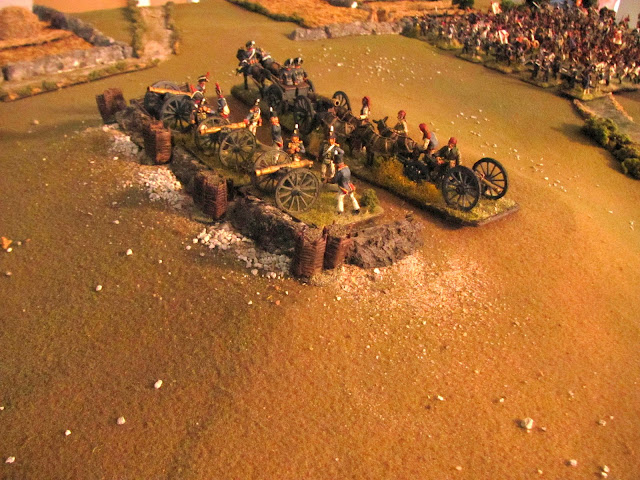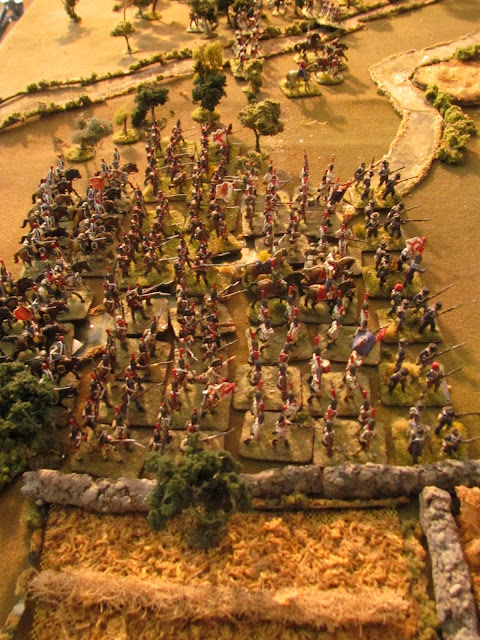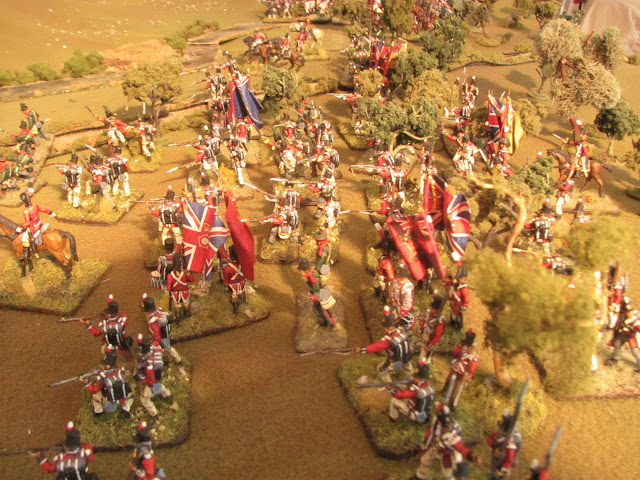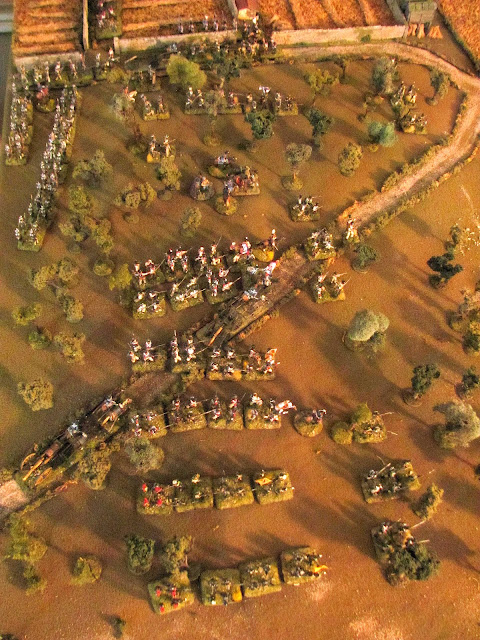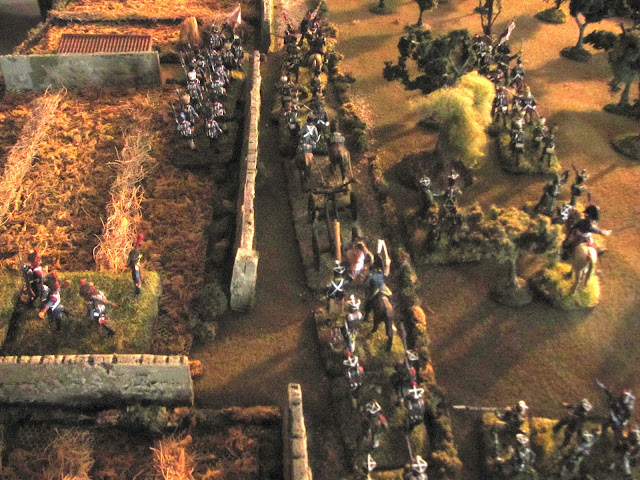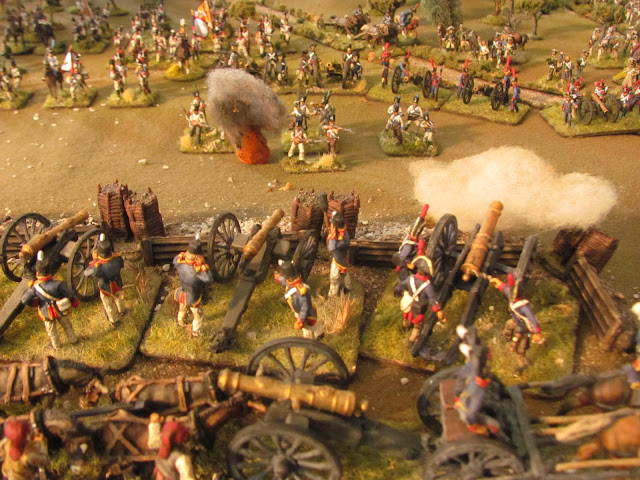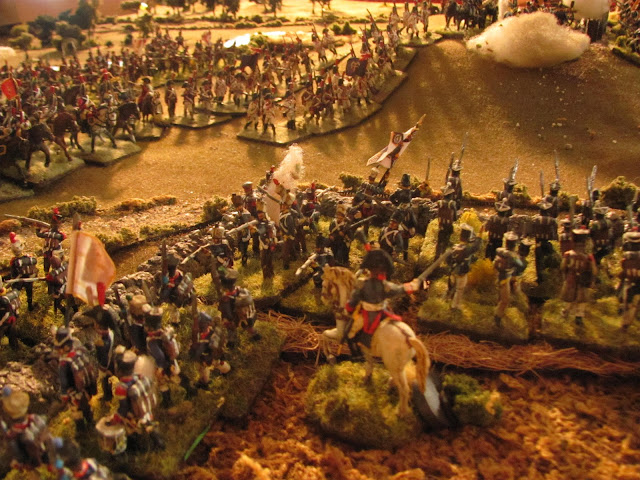We moved on to the fourth scenario in O'er the Hills, Jonathan Jones Peninsular War scenarios book, the attack on the Pajar Vegara Redoubt. After the failed morning attack on the British left Victor was back at it, launching a major attack a few hours later. This scenario is just a small part of that larger action, intended as a pinning attack by Leval's 2nd (German) Division on the British right which ended up drifting closer to Talavera, emerging from the olive groves in front of the Pajar Vegara Redoubt at the intersection of the Anglo/Spanish lines.
The game was played on a 6'X4.5' table using my 1/72 scale toy soldiers, including the newly minted German Division, the result of several months labour at my painting table. As always, we used the Over the Hills ruleset.
The Anglo/Spanish line
The Anglo/Spanish forces begin the battle west of the Portina stream, a dry creek bed which had little impact on the battle. These forces are just west of Talavera, in and around the orchards, and mark the intersection between the Spanish and Anglo armies. On the east side of the Portina (left) a redoubt has been hastily built housing an Anglo/Spanish battery, the Pajar Vegara Redoubt. It commands a low hill in this area. To the south of this (top of picture) can be seen the edge of the walled enclosures that indicate the outskirts of the town.
The Redoubt
The redoubt house a British battery of 3 pdrs. and a half battery of Spanish 12 pdrs.
The Redoubt, looking east towards the orchards which are still concealing the advancing enemy.
3rd Spanish Division on Anglo/Spanish right
The Spanish general, Portago, forms up his troops in attack columns, with his light infantry (Cazadores de Antequerra) spread out in front in skirmish formation. These are followed by his provincial militia (Badajoz and Guadix) and safely back where they can get up to no mischief after their fiasco the previous night (firing a hasty volley at a French cavalry patrol and then running off, looting the baggage train on the way), three newly raised and untested militia battalions, two from Badajoz and the third the Imperial of Toledo. The El Rey Line Cavalry Regiment are positioned at the rear.
British on left
Campbells’ troops (1st and 2nd Brigades, 4th Division) are arrayed in open order in the orchards west of the Portina, on the left and to the rear of the battery.
German Division advances through olive groves
Leval’s 2nd (German) Division of IV Corps has arrived in the olive groves just north of Talavera. Originally intended as a pinning move on the British right the broken ground seems to have caused them to drift further south, emerging directly in front of the Pagar Redoubt. The 3rd Brigade (Hesse Durmstadt and a small Frankfurt contingent) are on the German left (top) closely followed behind by 4th Brigade’s Poles. Centre is 2nd Brigade (Dutch, in white, approaching road) while on the right (bottom) marches Baden and Nassau.
German right wing
On the German right Leval’s 1st Brigade (Baden on left and Nassau on right) move in columns of companies to the edge of the orchards with their cannon following on the road. The Dutch (2nd Brigade) take the centre (far left of photo).
German left wing
The 3rd Brigade (Hesse Durmstadt and a small Frankfort contingent) march forward rapidly through the enclosures bordering Talavera, followed by the Poles. (Historically the Poles were not used in this attack but they are made available as a scenario balancing option, with their use calling for the redoubt to be held for two turns if taken.)
Hmmmm... Waarom zijn er kanonnen?
As the 2nd and 3rd Brigades’ skirmish line reaches the orchard edge the redoubt’s guns open up. Leval is surprised to find his troops emerging directly in front of the Anglo/Spanish battery!
British light bobs skirmish with Nassau voltigeurs
Campbell quickly advances his line abreast of the redoubt, throwing his light bobs on to his left flank to engage from the banks of the Portina as the enemy emerge from the orchards.
Frankfurt and Hesse take up position in the enclosures
Leval’s troops manage to reach the stone walled enclosures south of the redoubt, narrowly beating the Spanish 2nd Cazadores de Antequerra who begin firing on the enemy lines sheltered behind the walls. It is Leval’s intention to use this strong position on the flank to anchor an attack by the Poles on the redoubt. Meanwhile the 1st and 2nd Brigades on the German left would pin the British and occupy the fire of the enemy guns.
Poles following up
With the enclosures occupied the two Polish battalions move up in support.
Dutch skirmishers in front of redoubt
Bad timing and an order mix up brings the 1st and 2nd Brigades out of the orchard and into the open. The Dutch skirmishers begin to exchange fire with the redoubt.
Allied guns in action
The British 3 pdrs. shell the Dutch while the big Spanish 12 pdrs. turn their attention to the enemy cannon, now emplaced to their front.
Poles also take up positions in the enclosures
As the Polish battalions move in next to the 3rd Brigade their voltigeurs also advance on the redoubt.
Overview
On the left Campbell has managed to get his British troops drawn up into three lines abreast of the redoubt, while his skirmishers (far left) engage Nassau from the banks of the Portina. In the middle Dutch skirmishers storm the guns while to the right the Spanish commander Portaga has his Badajoz Provincial Militia drawn up in two lines guarding the guns’ south flank. To their right the Spanish light infantry skirmish against the enemy which has taken cover in the enclosures bordering the town, while the Spanish cavalry have maneuvered forward, waiting for an opportunity to charge (far right, bottom). To the rear Portaga has his three battalions of raw militia arrayed in column, not wanting to risk them in the front lines.
Top left Nassau, Baden and the Dutch form up just out of the orchards, threatening the British, while the German guns (three batteries) engage the enemy at long range. Top right, 3rd Brigade and the Poles get ready to attack the redoubt in strength, but the presence of the Spanish cavalry are making it difficult for them to venture forth.
Dutch voltigeurs storm the redoubt
As the Spanish 12 pdr. turns to engage the enemy on its flank the Dutch voltigeurs take advantage of this to storm the guns.
First attack driven off
But they are thrown back and routed in the face of the 3 pdr. fire.
Nassau line advance on British left
Nassau troops in line advance on the British skirmishers, driving them off their flank. But the skirmishers quickly return and continue to pester the German right with musket and rifle fire.
El Rey charge Germans on Spanish front
The lead squdarons of Spanish cavalry see an opening and charge the 3rd Brigade’s small skirmish battalion. This is easily routed but the Spanish horse are broken as they clash with the Frankfort battalion, well-ensconced behind the stone walls.
Granjean rallies his troops
The Hesse Darmstadt commander Granjean holds his troops steady in the face of cannon fire from the redoubt, as the remaining squadrons of El Rey move forward to threaten the French left.
Baden storms the redoubt
With time running out, the Poles unable to move forward in face of the Spanish cavalry and Leval clamouring for the redoubt to be taken, Baden takes over the assault on the enemy battery. But the first attack is driven back and the troops routed.
2/7th Foot driven back by a devastating volley
Myers’ 2/7th volley and charge some enemy skirmishers encroaching on the flank of the redoubt. The skirmishers slip back but before the 2/7th can retreat to its original position it receives a devastating volley from the Dutch that drives it back onto its supports, reeling.
Baden driven off a second time
An attempt by Baden’s second battalion is driven off by a massive blast of canister as the Spanish 12 pdr. swings back into action on the front.
Baden routing
This second failed attempt by Baden has taken them out of the battle as both battalions rout to the rear.
El Rey scatters Leval's right
With Baden routed Leval finally throws his Polish reserve into the fight. But the Spanish cavalry is ready for an assault on this flank and sweeps away the lead Polish battalion, which fails to form square as it ventures out from the enclosures. In the following chaos the Spanish horse overruns Granjean’s battery, which had pushed forward close to the redoubt under cover of Baden’s attack and scatters the Polish voltigeurs, finally creeping forward after being routed previously. The German Division’s left flank attack is over before it had begun!
Final Dutch attack driven off
In one last desperate attempt to storm the redoubt the Dutch 1/2me almost manage to fight their way over the barricades, only driven off at the last moment by a very battered but determined British gun crew in hand to hand fighting.
Game end
With the failed Dutch attack Leval threw in the towel. Both flanks of the Anglo/Spanish line were still holding firm and the Poles were now teetering on the edge of being broken as was the Baden/Nassau brigade. Time had run out and the German Division prepares to withdraw, after bravely tying to storm the redoubt in no less than five separate attempts.
We all agreed this was a very tough nut to crack. The presence of the Spanish horse was able to pretty effectively tie up the entire German left flank and both Campbell’s British and Portago’s Spanish were happy to stay put and let the enemy come to them. Finally, the redoubt was a formidable feature to be taken and even if it had fallen, would have been difficult to hold as there were still significant Allied reserves available for a counterattack.
Interestingly enough our result, even with the inclusion of the Poes, was quite close to the historic outcome, including the successful El Rey cavalry attack towards the end sending the enemy packing.


